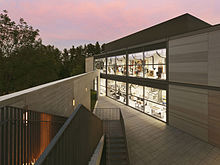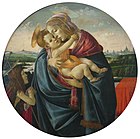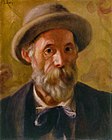Credit Linesterling and Francine Clark Art Institute Williamstown Massachusetts Usa
 The original 1955 marble building, designed past Daniel Deverell Perry. | |
| Location within Massachusetts | |
| Established | 1955 (1955) |
|---|---|
| Location | 225 South St, Williamstown, MA 01267 |
| Blazon | Art Museum and Inquiry Institute |
| Accreditation | American Alliance of Museums |
| Founder | Robert Sterling Clark and Francine Clark |
| Architect | Daniel Deverell Perry, Tadao Ando, Annabelle Selldorf |
| Website | clarkart |
The Sterling and Francine Clark Art Institute, commonly referred to as the Clark, is an art museum and research institution located in Williamstown, Massachusetts, United States. Its drove consists of European and American paintings, sculpture, prints, drawings, photographs, and decorative arts from the fourteenth to the early twentieth century. The Clark, along with the Massachusetts Museum of Gimmicky Art (MASS MoCA) and the Williams College Museum of Art (WCMA), forms a trio of art museums in the Berkshires. The institute also serves as a middle for inquiry and higher learning. It is home to various research and academic programs, which include the Fellowship Program and the Williams Higher Graduate Plan in the History of Fine art. It is visited by 200,000 people a twelvemonth.[1]
History [edit]
Origins [edit]
"The Clark" was created by entrepreneur, soldier, explorer, and prominent art collector Robert Sterling Clark, and his wife, Francine. Afterward numerous adventures in the Far Eastward, Sterling settled in Paris in 1911 and used a considerable fortune inherited from his grandfather (a principal in the Singer Sewing Machine Company) to begin amassing a private art collection. Francine joined him in collecting works of fine art after their spousal relationship in 1919.
The Clarks kept their collection largely individual, rarely lending out any works. With the onset of the Common cold War and rapid nuclear ammunition, they became increasingly worried nearly the prophylactic of their artworks. They wanted to protect their collection from a possible assail on New York City, where they lived and where the expected heir of their collection, the Metropolitan Museum of Art, was located. As such, the Clarks began looking at sites in rural New York and Massachusetts with the intention of founding a museum for their art.
They visited Williamstown, Massachusetts in 1949 and began having conversations with town leaders and the administrators of Williams Higher and the Williams College Museum of Fine art. Sterling had ties to the college through his grandfather and father, both of whom had been trustees. A charter for the Clark was signed on March fourteen, 1950 and the Institute opened to the public on May 17, 1955 nether its first managing director, former silver dealer Peter Guille.[2] The Clark has since become a destination for tourists, art lovers, and scholars, helping to establish the cultural reputation of the Berkshires.

Rock Hill Center at the Clark Art Establish.
Architecture [edit]
The original marble gallery building, designed by Daniel Deverell Perry, opened in 1955. The Pietro Belluschi-designed Manton Research Heart, housing the library and research programs, was completed in 1973. The Clark embarked on a long-term project in 2001 to improve its campus, enlisting the help of mural firm Reed Hildebrand and architects Tadao Ando and Annabelle Selldorf.[3]
Reed Hilderbrand redesigned the campus grounds, revamping nearby walking trails, planting one,000 trees, and creating a reflecting pool fed by recycled h2o.[4]
Tadao Ando[5] designed 2 additions: the Lunder Centre at Rock Loma and the 42,600-square-foot Clark Center, which opened in 2008 and 2014, respectively.[vi] Envisioned as a sanctuary in the woods waiting to be discovered, the Lunder Heart features two galleries and a seasonal terrace café. It is also home to the Williamstown Fine art Conservation Center, the largest regional conservation heart in the country.
The Clark Eye includes more than 11,000 foursquare feet of gallery infinite for special exhibitions; new dining, retail, and family unit spaces; and an all-glass Museum Pavilion that creates a new entrance to the original Museum Building. Situated northwest of the Museum Building, the stone, concrete, and glass Clark Center is the centerpiece of the Clark's campus and serves as its primary visitor entrance.
Annabelle Selldorf[7] was commissioned to renovate the campus' existing structures. In the 1955 original marble building, galleries for American and decorative art were added and exhibition space was increased past 15%. In the Manton Inquiry Heart,[8] which reopened in 2016, the auditorium and central courtyard were renovated and several galleries and a study center were created. Its renovation marked the completion of the Clark's all-encompassing expansion project.[ix]
Research and Academic Plan [edit]
The Enquiry and Academic Program (RAP) is the manifestation of the Clark's original delivery to academic research and scholarly written report. The program began in the late 1990s with the establishment of the Clark Library and the Graduate Program in the History of Art. Under the management of John Onians, Michael Ann Holly, and Darby English, the programme has since widened its purview to partner with both regional and international institutions and scholars to challenge and expand the scope of the study and production of the visual arts. Caroline Fowler is the Starr Director of the Enquiry and Bookish Program at the Clark and teaches in the Graduate Programme in the History of Fine art at Williams College.
The Research and Bookish Program likewise awards between ten and xvi Clark Fellowships a year, ranging in duration from iv weeks to x months. Clark Fellowships allow promising scholars, critics, and museum officials opportunities for research outside of their professional obligations. Fellows, forth with scholars and students from all stretches of the world, are encouraged to participate in the various conferences, colloquia, workshops, curator round tables, and seminars hosted past the program.
Publications like The Clark Studies in the Visual Arts,[10] as based on the proceedings of the annual Clark Conferences, serve as some other forum for the interdisciplinary exploration of art historical issues.
Williams Higher Graduate Program in the History of Art [edit]
The Williams Higher Graduate Program in the History of Fine art, established in 1972 in cooperation with the Clark, is an intensive two-yr program that combines academic work, curatorial internships, workshops, an international report bout, and a range of instructors to culminate in a degree of the master of arts in the history of fine art. Located on the Clark Campus, the plan draws on and works closely with the art history resources of both institutions. Of the about 1,500 graduates of the program, notable alumni include Cara Starke, Managing director of the Pulitzer Arts Foundation, James Rondeau, Director of the Art Institute of Chicago, and Paul Provost, Deputy Chairman of Christie's.
Educational programs [edit]
The Clark offers all-encompassing public educational programs that range from guided gallery talks to lectures, motion picture serial, studio art courses, and interactive activities for children to engage visitors of all ages and backgrounds with the Clark's collections and exhibitions. The interactive nature of the programs reflects the general mission of the Clark to advance the public agreement of art's transformative power.
Clark Prize for Excellence in Arts Writing [edit]
The Clark Prize for Excellence in Arts Writing has been awarded every other year since 2006. The prize "celebrates informed, insightful, and accessible prose that advances the public understanding and appreciation of the visual arts."[ citation needed ] The laurels is presented for "critical or historical writing that conveys complex ideas in a fashion that is grounded in scholarship yet appealing to a diverse range of audiences."[ citation needed ]
In 2006, three people were honored. Since then, one person has been selected each time it has been given.[eight] Winners of the Prize are:
- 2006: Kobena Mercer, Linda Nochlin and Calvin Tomkins
- 2008: Peter Schjeldahl
- 2010: Hal Foster
- 2012: Brian O'Doherty
- 2015: Eileen Myles
Library [edit]
Established in 1962, the Clark library is one of the major fine art reference and research libraries in the United States.[eleven] The library has over 280,000 volumes and many special collections, including Robert Sterling Clark's rare books collection. Materials include standard art reference titles and databases, monographs and scholarly journals in 65 languages from more than 140 countries, exhibition catalogs and museum publications, auction catalogs (including many nineteenth- and early twentieth-century catalogs), and artists' books.[12] The library is open up to the general public and admission is free.
Management [edit]
The museum'south well-nigh recent $145 million expansion project has been funded through individual donations, foundation support, the Massachusetts Cultural Facilities Fund, and bond financing organized in conjunction with the Commonwealth of Massachusetts.[ commendation needed ]
Collection [edit]
Initially, the Clarks concentrated on Italian, Dutch, and Flemish Old Master paintings. Over time, their tastes shifted towards artists similar John Vocalizer Sargent, Edgar Degas, Winslow Homer, and Pierre-Auguste Renoir. Later on 1920, the Clarks focused mainly on the art of 19th-century France — specifically works of Impressionism and the Barbizon Schoolhouse. Over the next 35 years, the Clarks would add together to their private drove, increasing their holdings of paintings, porcelain, silver, prints, and drawings from the early on fourteenth to the early twentieth century.
Since its establishment in 1955, the Clark Art Institute has connected to grow its drove through acquisitions, gifts, and bequests, with a contempo focus on expanding its photography collection. In 2007, the Manton Foundation donated the collection of its founders, Sir Edwin and Lady Manton, to the museum. The Manton Collection of British Art[xiii] includes more than 200 works by British artists like J.M.Due west. Turner, Thomas Gainsborough, and John Constable.[fourteen] In 2013, Frank and Katherine Martucci gave the museum viii George Inness landscapes, supplementing his ii works already in the collection.[15]
Today, the museum is best known for its works of French Impressionism, specifically the paintings of Renoir, academic paintings past Jean-Léon Gérôme and William-Adolphe Bouguereau, and its collection of European and American silver.
Collection highlights [edit]




One-time Master paintings [edit]
-

Botticelli and workshop, Madonna and Child with the Young Saint John the Baptist, c. 1490-1500
19th-century paintings [edit]
Impressionism and Mail service-Impressionism [edit]
-

Claude Monet, Rouen Cathedral, the Façade in Sunlight, c. 1892-1894
-

Pierre-Auguste Renoir [edit]
-

-

Pierre-Auguste Renoir, Thérèse Berard, c. 1879
-

Pierre-Auguste Renoir, Sleeping Girl with a Cat, c. 1880
-

Pierre-Auguste Renoir, At the Concert, a Box at the Opera, c. 1880
-

Pierre-Auguste Renoir, Self-portrait, c. 1899
Academic paintings [edit]
American paintings [edit]
Manton Collection of British Fine art [edit]
Featured Prints and Drawings [edit]
Photography [edit]
References [edit]
- ^ "Visitor Eye, Clark Art Found". Retrieved Baronial 21, 2017.
- ^ "Clark Art Institute to gloat 60th anniversary Sun". The Berkshire Eagle . Retrieved January 25, 2017.
- ^ "The Clark Art Found, Williamstown, Massachusetts". Library of American Landscape History. May one, 2015. Retrieved January 25, 2017.
- ^ Smith, Roberta (July 10, 2014). "Clark Fine art Found Reopens With New and Renovated Space". The New York Times. ISSN 0362-4331. Retrieved January 25, 2017.
- ^ "安藤忠雄 Tadao Ando". tadao-ando.com. Archived from the original on February 11, 2015. Retrieved January 24, 2017.
- ^ Quarterly, Fine art & Compages (Dec 21, 2015). "The Clark Institute of Art: Tadao Ando, Selldorf, Reed Hilderbrand, Gensler / Architects 2014". Art & Compages Quarterly . Retrieved January 25, 2017.
- ^ "Welcome - Selldorf Architects - New York". Selldorf Architects - New York . Retrieved Jan 24, 2017.
- ^ Stapley-Brown, Victoria (Nov 11, 2016). "Clark Art Constitute reopens its 'chirapsia heart', the Manton Research Heart". theartnewspaper.com. The Art Newspaper. Retrieved Jan 26, 2017.
- ^ "Clark Art Institute / Tadao Ando Architect & Associates + Selldorf Architects + Reed Hilderbrand Landscape Architecture + Gensler". ArchDaily. July 22, 2014. Retrieved January 26, 2017.
- ^ "Books from "Clark Studies in the Visual Arts" | Yale University Printing". yalebooks.com . Retrieved January 25, 2017.
- ^ Murray, Stuart; Basbanes, Nicholas; Davis, Donald (2009). The library: An illustrated history. New York: Skyhorse Publishing. p. 209. ISBN978-one-62873-322-8.
- ^ "Library FAQs". The Clark Library . Retrieved Apr eleven, 2021.
- ^ Miller, Michael. "The Manton Drove: the Clark becomes a major repository of British art overnight. -". berkshirefinearts.com . Retrieved January 26, 2017.
- ^ "Landscape, innovation, and nostalgia : the Manton collection of British art in SearchWorks". searchworks.stanford.edu . Retrieved January 26, 2017.
- ^ Villarreal, Ignacio. ""George Inness: Gifts from Frank and Katherine Martucci" opens at the Clark Fine art Institute". artdaily.com . Retrieved Jan 26, 2017.
External links [edit]
- Official website
- "Richard Kendall: Picasso Looks at Degas" – video
Coordinates: 42°42′28″N 73°12′49″West / 42.70778°N 73.21361°W / 42.70778; -73.21361
Source: https://en.wikipedia.org/wiki/Clark_Art_Institute





0 Response to "Credit Linesterling and Francine Clark Art Institute Williamstown Massachusetts Usa"
Postar um comentário